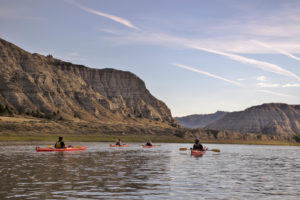 Throughout the second section of the Montana Afoot and Afloat course, I have been able to apply knowledge from the first section to understand this landscape more precisely. Being in Montana, first in the Scapegoat Wilderness, and now floating down the Missouri River, I have realized how small I am, but how enormous my actions can be. I wonder how these ecosystems would function without human intervention. Why are we here and what is our purpose? Looking out onto the landscape as we float down the Missouri has opened my mind to the preservation and conservation efforts this land needs to flourish.
Throughout the second section of the Montana Afoot and Afloat course, I have been able to apply knowledge from the first section to understand this landscape more precisely. Being in Montana, first in the Scapegoat Wilderness, and now floating down the Missouri River, I have realized how small I am, but how enormous my actions can be. I wonder how these ecosystems would function without human intervention. Why are we here and what is our purpose? Looking out onto the landscape as we float down the Missouri has opened my mind to the preservation and conservation efforts this land needs to flourish.
The wide, murky Missouri River came as a shock after experience the fresh, vibrant, freezing, flowing mountain waters of the Scapegoat Wilderness. Paddling from Coal Banks to Kipp Landing, I learned about the various types of land ownership. This flowing body of water is in constant motion as it feeds the Mississippi River. This is one of the hydrologic features in the Rocky’s that essentially effects the majority of the lower 48 states.
The Missouri is the first stretch of river that I believe needs cleaning up. I quickly saw the overabundance of cattle and their impact on the river. Water quality is an issue around the world, so why would we promote this style of intensive management when water is one of the most important resources? If we use wag bags to prevent our feces from being engulfed by water runoff, we are simply disposing our waste in another geographic location (out of sight out of mind). I cannot see the nourishment that this river may provide to the species like the sturgeon, the rancher, or millions of organisms and people living downstream by adding more disposal to the river. If we want change, I believe it starts with a positive course of action and one that becomes a daily routine.
We have touched on the relationships ranchers have with each other and with state and national governments. I think we have forgotten about the landscape’s most valuable tool/nurturer, water. My experience on the Missouri has opened my eyes to our actions on this planet much more than what I have been able to grasp while in the classroom in Wisconsin. I believe we are here for some amazing reasons, but we have found a way to destroy valuable assets to our existence and we are the only ones that can repair the damages.
Water is the key component to this landscape and the interconnected body of the environment, society, and economic functions. A simple course of action can spark more people to adopt better methods, even without government or policy intervention. Positive actions for the environment should be the norm. A norm is created by securing some relationship or bond with the land that is acquired over time; in early childhood or even later in life. However, once a person obtains a relationship with the landscape, a deeper meaning and connection to the landscape will evolve. I have learned this through education and seeing how others perceive the landscape. Without the love of the ecosystem there may be a part missing from your soul or true character. I believe early education with our youth needs to include experiencing mother-nature so the next generation of future ranchers or tourists may see the land and water from a different perspective. A perspective that seeks to help preserve, not destroy with a blind eye.